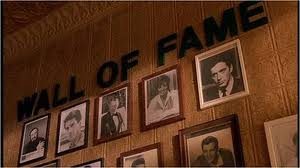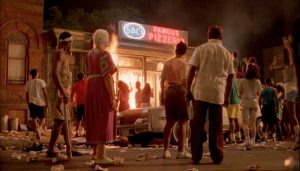Hailey Albright
HIST 218
First Blog Post
Do the Right Thing
For this project, I went to the screening of Do the Right Thing. This film is very detailed, but I go over the main plot below. Being as detailed as it is, the message is not clear, and the purpose may not be to share a message at all. The purpose of this movie is likely to start a conversation, which it does. The definition of racism is a question brought up by this movie. Similarly to the definition, the issue of racism itself is very complex. These changes over time have made racism even more difficult to fight. This complexity and dimensionality are showcased between the book Barracoon and the movie “Do the Right Thing”.
This movie was written and directed by Spike Lee and came out in 1989. The setting is the hottest day of the summer in a mostly black neighborhood in Brooklyn. Mookie is the main character and a Black man who worked at a pizza shop owned by Sal Frangione. Sal was an Italian-American who owned and ran his pizza shop in this neighborhood for 25 years and almost everyone loved the place. One of Mookie’s  friends, named Buggin’ Out went to Sal’s pizza place and confronted Sal about only having white people on his “Wall of Fame”. He believed that because the pizza place was in a black neighborhood, Sal should put up pictures of black people. Sal refused and Buggin’ Out was kicked out. Shortly after, he tried to get others to boycott Sal and the pizza place. However, the only person who would join him was Radio Raheem. Radio Raheem was a guy who walked around the neighborhood with a boom box blaring the same song: “Fight the Power”. He joined Buggin’ Out because he also had an altercation with Sal earlier in the day. Sal would not serve him until he turned off the music. When they did go to boycott, they went inside the pizza place blaring music and a yelling match ensued. Eventually, Sal smashed the boom box and Radio Raheem attacked him. Everyone joined the fight, the pizza place was destroyed and lit on fire,
friends, named Buggin’ Out went to Sal’s pizza place and confronted Sal about only having white people on his “Wall of Fame”. He believed that because the pizza place was in a black neighborhood, Sal should put up pictures of black people. Sal refused and Buggin’ Out was kicked out. Shortly after, he tried to get others to boycott Sal and the pizza place. However, the only person who would join him was Radio Raheem. Radio Raheem was a guy who walked around the neighborhood with a boom box blaring the same song: “Fight the Power”. He joined Buggin’ Out because he also had an altercation with Sal earlier in the day. Sal would not serve him until he turned off the music. When they did go to boycott, they went inside the pizza place blaring music and a yelling match ensued. Eventually, Sal smashed the boom box and Radio Raheem attacked him. Everyone joined the fight, the pizza place was destroyed and lit on fire,  and the police were called. When the police arrived, they arrested Radio Raheem who they killed in the process. Although there are many other parts and details to this movie, this is the main plot line.
and the police were called. When the police arrived, they arrested Radio Raheem who they killed in the process. Although there are many other parts and details to this movie, this is the main plot line.
The meaning of this movie is not straight forward. There are multiple ideas and constructs showcased. In the discussion after the movie, one of the speakers suggested that there probably isn’t a specific meaning behind the film because that’s how Spike Lee generally writes and produces his movies. After watching this movie and piecing details together, I was originally thinking that the purpose behind this film was to say that to “Do the Right Thing” was to act like MLK Jr. or Malcolm X by staying away from violence. MLK Jr. was a pacifist and Malcolm X said violence was to be used if necessary. I was thinking this because the character Smiley was constantly bringing up the two and he posted a picture of them on the “Wall of Fame” after he set fire to the pizza place. In addition, at the end of the movie, a quote from each was shown on the screen. Both of these quotes were talking about not using violence. However, after thinking about it, I think one might say that the meaning was more likely that the amount of violence (whether none or a lot) did not matter and would not change how Black people were treated. This point is shown by the death of Radio Raheem who had used  violence and by employing the images of MLK Jr. and Malcolm X. Even though they both preached peace and non-violence (or if necessary), they were both killed as well. Somebody made a good point in the discussion following the movie and said that the purpose is likely not necessary for a message, but to spark a conversation.
violence and by employing the images of MLK Jr. and Malcolm X. Even though they both preached peace and non-violence (or if necessary), they were both killed as well. Somebody made a good point in the discussion following the movie and said that the purpose is likely not necessary for a message, but to spark a conversation.
Based on the discussion about the movie between the speakers and the audience, I would say that Spike Lee was successful if his intent was to spark a conversation. Although race and racism aren’t quite as taboo of topics as they were 15 years ago, they were much worse when this movie came out. Something I learned from one of the speakers was that when this film came out, it was considered upfront and in your face. However, as time has gone on and awareness has risen, people are talking about racism more and more. This raises the question, what is racism? This was a question brought up in the discussion and although the answer is very complex, my favorite definition given was “lack of appropriate concern and intent to discriminate against minority”. The timelessness of this definition is shown between Barracoon and the film. Cudjo Lewis explaining the work conditions when he was enslaved in the mid -1800s (and of course the whole idea behind the Middle Passage) shows the intent to discriminate. This is also shown when he talks about how his children were treated by others, being called monkeys and told to go back to Africa. The lack of appropriate concern is best shown by the fact that this book wasn’t actually published until 2018 because the story was written phonetically. The movie “Do the Right Thing” shows intent to discriminate by Sal’s oldest son, Pino. Pino purposely treats black people differently and is very mean to many of them by making remarks and talking about how much he hates the neighborhood. This is also shown when the cops kill Radio Raheem. The lack of concern is shown by Sal. Although Sal isn’t purposefully racist and for the most part treats the people in the neighborhood okay (he mentions how much he’s enjoyed watching people in the neighborhood grow up and how he doesn’t want to leave), he does make racist remarks towards people, when he is frustrated. His feeling of frustration was experienced by others especially because it was such a hot day. This only worsened the issues and made them more complicated.
Racism is shown in many different dimensions in the book and the film which displays how complex the issue of racism is and always has been. Because of this, it has persisted. One of the audience members brought up a metaphor she read in a book that talked about moving walkways in airports. The metaphor was saying that you must move faster in the opposite direction of the walkway to make any change. The racism in the U.S may have started with slavery, but has continued in many other ways (for example, the KKK, redlining, Jim Crow Laws, and police brutality). The development of racism which has added to the complexity has made moving faster in the opposite direction even more difficult.
The movie “Do the Right Thing” and the book Barracoon demonstrate how racism has evolved over time and how that affects people’s daily lives. Both do a great job at starting conversations about racism: what it is, how we see it day to day, and how we can start working on the issue even as it continues to change.

